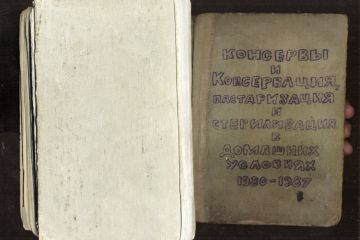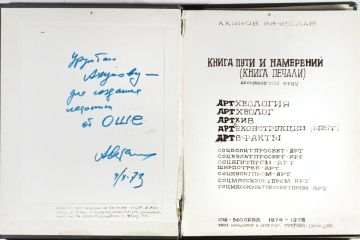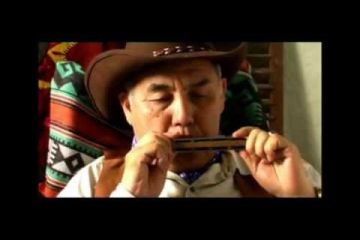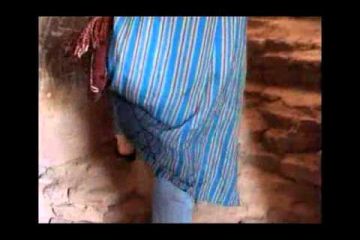The artist, Vyacheslav Akhunov, stands out among Uzbek artists. After having graduated from the Moscow State Institute of Art in 1979, he, as a quite developed artist-conceptualist, settled down in the town of Fergana. Having in mind his rejection of Soviet art of totalitarian system, his choice of conceptualism and actionism grounded on countercultural values and personal moral choice as the core of his art seems to be reasonable.
In 1962 Vyacheslav Akhunov has entered in artistic college, located in capital of the Soviet Socialist Republic of Kyrgyzia – Frunze city. Then he served as the ordinary soldier in rows of the Soviet Army.
His first teacher who was also his father, artist Urumbaj Akhunov, took lessons in studio of a well-known fellow countryman from Fergana, Alexander Volkov who was the first Central Asian avant-garde artist of the 20th century. From the fifties to the beginning of sixties Vyacheslav Akhunov spent his summer vacations in the countryside with his father who worked at that time as the artist in the South-Kyrgyz archaeological expedition, which was headed by the archeologist Yuriy Baruzdin.
After his voicing the protest against military actions in Afghanistan which followed by another call to KGB , Vyacheslav was compelled to leave the city of Fergana and took up the invitation by the Chairman of the Artist's Union of Uzbekistan, Rakhim Akhmedov, to move to capital of the Soviet Socialist Republic of Uzbekistan - Tashkent.
In 1982 the artist became a member of the Artist's Union. Paradoxically, it was partially initiated by the omnipotent First secretary of the Central Committee of the Communist Party of Uzbekistan Sharaf Rashidov, who had visited the All-Union youth exhibition arranged in the exhibition hall of the Artist's Union of Uzbekistan.
The picture "Old Mill" overwhelmed the Party boss with sentimental memoirs of the hungry childhood so much, that he immediately ordered to allocate from an available housing fund an apartment to the homeless artist.
We need to take into account the state of society at that time: passive membership in the Artist's Union legitimized the artist's right to exemption from service in the Soviet institutions and by-pass Penal Code article which punished for "loitering" or confirmed evasion of work.
The 80-s were characterized by dual nature - movement on a dangerous edge and, simultaneously, drifting as a member of the Artist's Union. There was no opposition between cultural freethinking (underground) and official culture on Central-Asian ideologically homogeneous art sscene compared to Moscow one.
One shouldn’t forget, that in 50-80th an overhelming part of Moscow, Leningrad and as a whole the Soviet nonconformists were legitimate members of the official organization - the Artist's Union of the USSR with all privileges following from here - none of them was subjected to repression, condemned and sent to prison, a concentration camp as a dissident, or the participant of the Helsinki group or the fighter for civil human rights.
Vyacheslav Ahunov's first projects, as a kind of crossing the limits of the picturesque form and radicalism of art statements, stylistically appealing to the Avant-garde, and also the strict supervision of artists’ activity by party authorities and KGB, resulted in frequent trips to mountains or work at the apartment or in a workshop.
In 1974-1987 the artist works on the realization of the serial projects in collage technique: “Lenin’s Plan of Monumental Propaganda”, “Leniniana by Vyacheslav Akhunov”, “Stamps, Seals, Stencils”, dedicated to the figure of the Revolution leader V.I.Lenin, but with certain portion of irony, first of all sneering at idolization of the leader, especially by the way of creating agitational-propagandistic fiction known as Socialistic Realism. In his collages the artist uses serial illustrative printed material from numerous sources: books, magazines on art, albums, and posters. Simultaneously the artist works at the project “ART-chaelogy USSR. Socialistic Epoch.”, “The Doubt (Asking again)”, “Bijouterie of the U.S.S.R.”, “Philosophy of the Desert. "Sand of Oblivion”, "Party Line".
“Socialit” – art-cheological reconstruction of Socialistic Epoch looks as if it's artifacts were suddenly opened by the art-cheologists after thousand years.
In the project “Bijouterie of the U.S.S.R.” the artist considers for his creative understanding so usual for soviet person signs and symbols carried ideological function as some fetish-things, signs of particular luxury, indicating social status of their holder, the enjoyment from the possession of these super expensive jewelry trifles. The artist creates the series of sketches of expensive jewelries: brilliant brooches, necklaces. At the heart of them lie the images of Lenin, breastplates and other soviet signs (Sickle and hammer, Star of U.S.S.R. Hero, State Quality Sign, and etc.), tests (“Lenin is alive”), abbreviated words (GULAG, KPSS, KGB, HKVD, VLKSM, etc.). The artist supposes to make them from white gold, grand number of brilliants, rubies and other precious stones. In 1976, being the student of the Moscow art institute, the artist developed conceptual idea "Ossuaries", opposing sacral urns for storage of human remains of fire-worshippers - Zoroastrians to the Soviet household urns, spittoons and the urns used for dumping bulletins during elections to the Supreme state bodies of the Soviet Union.
In 1977, an artist named the style of his works Socialist Modernism (Soc-Modern). He believes that Socialist Realism has not revolutionary potential. So called «Harsh Style» of Socialist Realism he calls "frozen socialist realism".
In the same year, a project "Alphabet of Totalitarianism" (ABC Great Glaciation).
Ready-made becomes almost the main trend for the artist. In the same year he created the conceptual project “Fly-Flaps. Signs and Symbols" - a series of fly-flaps with the state signs and symbols, portraits of members of the Political Bureau of the USSR glued to them.
In his diary the artist writes down: “Sooner or later one has to make a decision. One adopts the decision which gives him the chance to remain a humane-being in full sense of this word ". In 1977 the project "Fly-flaps" (ready-made) has been rejected by the commission of the Moscow Nonconformists Gallery on Small Georgian Str., for the reason being too much "provocative ".
But the same year Vyacheslav Ahunov created the project “Transparent life ", obviously hinting on the fact, that in the Soviet Empire the life of any person is screened by guarding bodies of the K.G.B. The project represented transparent objects made of plastic: the dog kennel, the parcel post, the personal safe, the toilet and the bedroom with transparent walls.
In aquariums with floating fishes the artist places posters, appeals and messages, characteristic for that epoch: " Are we building communism? ", and “Is he now more alive than others? ", " Is the party our driver? ", All statements were written with a question mark.
Among all concepts graphically expressed in 1976-1979 one can single out projects of poststructuralistic nature. First of all such projects as "Is it stuffy?", "Have we won?" and others. The projects are based on the concept of three-dimensional text and phrases presentation different to two-dimensional one.
For example the questions "IS IT STUFFY? " or "HAVE WE WON?", volumetric and of huge size, made of a bar and tide poles, squeezed in the exhibition space of the Arena, could become a vivid symbol of the time (such idea would be, in opinion of party functionaries, blasphemous jeer on existing authority " elected representatives of the people ").
The artist is not influenced by the American volumetric design-inscription "Hollywood", but expresses his vision of three-dimensional ideological ferro-concrete slogan-designs of the Soviet epoch, " the developed socialism with a human face " of the 60-70th which were erected on roofs of administrative and residential buildings, placed in parkways, in parks, near the brisk outcomes of the highways, made of reinforced concrete.
He is one of the first artists in the USSR who introduces volumetric text concept thus surpassing the limits of two-dimensional picture outlay experimenting with it and with all incorporated implications at his own discretion.
Since 1978 Akhunov has organized campaigns under the name "Igrizmy" (play-izms) or "Meditations, as worthless pastime of pantheizmatikov " ("pantheonizms") with long trips to sacred Sufi Mausoleums (Mellebaudes) in the mountains of Kyrgyzstan, Tajikistan and Uzbekistan and employs the territory of contemplation and undetached imagination for finding understanding of the world by means of oriental philosophy of Zen-Buddhism, Dao and Sufism.
The purpose for this was the perception of the artist's identity through nature as understanding himself in connection with alienation by a zone of a megacity (an urbanity landscape). But his interest in oriental philosophy made him to rethink his further progress in this direction ("… and if Buddhists state, that the purpose is to be fully identified with bases of the Universe, not upsetting them, turning away from subjective desires, aspirations and motivations I completely agree with them … it seemed to me unnecessary to solve problems by searching optimum display of the object by the subject especially by influencing them. That would be following the principle of the Western world in which conceptual thinking is a mental function aiming at explanations, instead of intuition functioning.
I accept the way of ultimate unity and identity of the subject and object, their merger, in readiness to enter in a state of unawareness, having got rid of the "I", having released consciousness from discursive thinking during perception, engaging intuitive way of reflection and reaction at full.. ") From the artist’s diary.
This period is marked by the beginning of psychological experiments with full darkness under the name " Black, Laid in Black " aiming at recognition of the existence of " black quasi-holes " as expressions of steady alternative to habitual and ossified, as acceptance of other language - language of Emptiness.
The project " Black, Laid in Black " originates from the collective action " Topography of Black " (1979), held in the mountains of Kyrgyzstan, which was a trip to the top of the mountain by a steep track in moonless night aiming at “switching on” internal sight and intuition.
The 80th became for Vyacheslav Akhunov the time of intensive building of confidence and creative freedom.
Almost in complete loneliness, but with greate desire to master new forms of self-expression, their mental value and spatial integrity, the artist tries to reveal transitions from sensual, psychological perception to logical analysis, and to track development of mutual structural links.
Sensitivity, reflection, space, time were considered by him as transition from passive "monotony" to active form and back, thus emphasizing " monotony and routine " of the existence in the communist regime.
In his installations and objects V. Akhunov investigates the hidden qualities of the form, using properties of clay, sand, felt, leather, such, as flowability, viscosity, drying, fragility, instability, managing the form, space and a sign in spatial extent, their emotional function on encouraging memory work.
Introducing new graphic forms to art of Uzbekistan the artist connects spatial properties of the material with properties of a created image, investigates interaction of unity and plurality of forms as uniform of semantic system of perception in which the separate part is identified with all others and all world as a whole.
Psychological experiments with " squeezed in dark space " were named by the artist as "Dialogues". Refrigerator cardboard boxes served as an initial material. Dialogues were conducted between people sitting in the boxes, in turn the boxes were in absolutely dark room. The artist aspired to increasing darkness in the box by external darkness, achieving the sensation of superfluous completeness.
All of the activity of " black in black " the artist marked as " black quasi-hole ", absorbing the present, the past and the future, mixing them and in exchange splashing out new intents.
It is enough to recollect personal obsession and author's inner conviction in actions, performances, happenings, installations, projects named " The Soviet pop art " and ready-mades of the end of 70 and 80th which were lead in an atmosphere of ideological reality. "Stuffy" (1976), " Fallen Meteorite " (1976), "By-pass " (1978), " Conjunction"(1979), " Total Inventory. Parts of the Infinite Register " (1986), " River of sweet ", "Sky-scraper" (1980), " Parts of the whole " (1981), " Collection of invaluables ", "Salute" (1982), " Have a Look in the Future ", " Black Holes " (1983), " Concert for String Tools ", "Traffic Warden", "Hymn", "Corner", slide-shows " Construction of the Babel tower " (1984), " Territory of Unnecessary Things ", " Application N2 " (1985), " Ladders in the Sky " and " Heavy Dream " (1987).
In 1989-1990, the artist packed his creative archive into boxes and decided to bring the archive into oblivion for 20 years. In the 90-s the artist is actively engaged in the field of literature and cinema. In 2008, part of the archive by Akhunov has been published.
Umida Alimova






